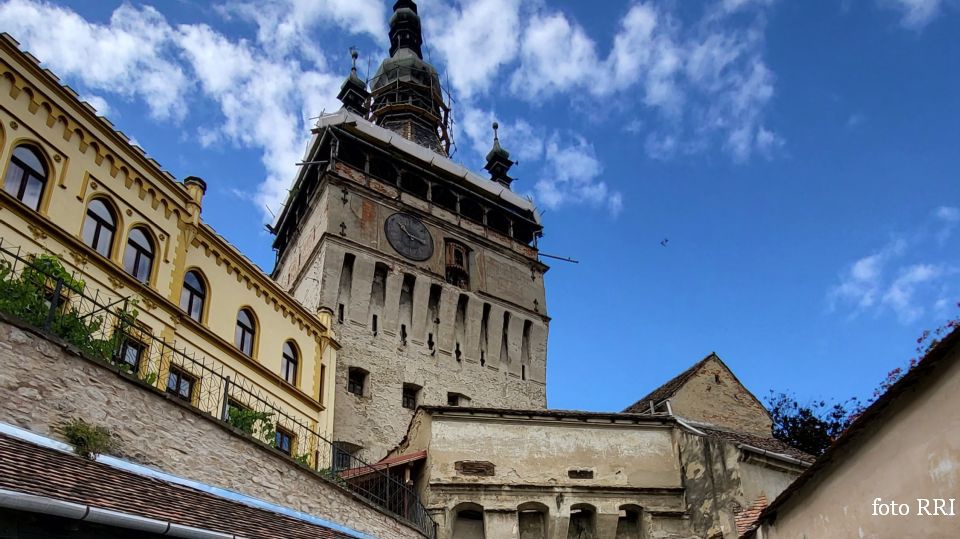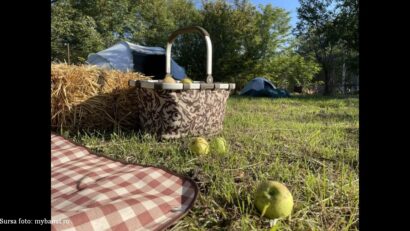Sighișoara, a fairytale destination
The medieval town of Sighisoara seems to have found the perfect balance between authenticity and modernity

Daniel Onea, 20.11.2025, 12:05
In the world of tourist destinations, few places manage to preserve their authenticity in the face of galloping modernity. Sighișoara, however, seems to have discovered the secret to perfect balance. Far from being a simple open-air museum, the citadel lives and breathes in tune with the 21st century, without ever forgetting its rich history. Thus, the vitality of the fortress is maintained, day after day, by its people. And in Sighișoara, one man has become a symbol of the place himself: Dorin Stanciu, the drummer of the fortress. For 20 years, his presence has been synonymous with the soul of the city. For Dorin Stanciu, Sighișoara is “Romania’s medieval jewel,” a destination to be discovered step by step, guild by guild. The city’s drummer not only tells its history, but personifies it, insisting that the entire city functions as a complex museum, dedicated to the guilds and crafts that were the basis of its development.
“Sighișoara is, of course, visited at least once by every tourist in Romania, but we expect them to return ten times, because it is the medieval jewel of the country. It is a destination that must be discovered in depth, through its guilds and crafts. It is worth visiting the Clock Tower, the only vertically developed history museum in Romania. Let’s not forget the House of Guilds, the House of Maps, the Monastery Church, or the Church on the Hill. In fact, the entire citadel is a museum. It is the best preserved of the seven Transylvanian fortresses and preserves a true “technological flow” of guilds: butchers, tanners, coppersmiths, tinsmiths, furriers, belt makers, weavers, tailors, bootmakers, locksmiths, coopers, and so on. Sighișoara is a very special place and it is worth promoting this unique history.”
However, Sighișoara’s charm lies not only in its stone buildings, but also in its unique human interaction. The drummer is not just a guide, but a host. Welcoming tourists in dozens of foreign languages, from Hebrew to Japanese, has become an iconic moment. It is more than a curiosity; it is a gesture of hospitality that breaks down barriers and creates an instant connection. This welcome is proof of the open spirit of a city that has been accustomed to visitors from all corners of the world for centuries.
“Tourists are very excited when I greet them. I welcome them in 60 languages, a unique gesture in Romania, perhaps even in the world. For example, if visitors arrive from Israel, I welcome them in their language, and the same goes for those from Japan. That’s why it’s so beautiful, because it creates a special energy. People come here from all corners of the world and absorb the energy of the ‘living drummer’ – a character who, historically, had four functions simultaneously: firefighter, bugler, night watchman, and drummer.”
The past is not only recounted, but reactivated. A recent initiative brings together characters in medieval costumes every Saturday evening to recreate the night watchman’s rounds, shouting “Silence!” as they did in the 17th century. Tourists are invited to join the guard, transforming themselves from spectators into participants. This living history is intertwined with legend. The drummer, in his role as an authorized guide, knows how to turn a tour of the citadel from a history lesson into an adventure, using local stories, such as that of the Schoolboy’s Staircase, to captivate his audience.
This vitality is complemented by the vision of the administration, which understands the importance of balancing the lives of locals and the expectations of tourists. Ioana Curuți-Popa, spokesperson for the City Hall, describes a city that does not live only for the summer season. Events are planned throughout the year, from the Christmas Market and New Year’s Eve party in Piața Cetății, to the installation of an ice rink at the base of the citadel, to preparations for the next edition, the 31st, of the famous “Medieval Sighișoara” Festival.
“We really want everyone who crosses our threshold to feel good, to feel at home. At the same time, we strive to maintain an essential balance between what the city’s residents want and what tourists expect to find here. In the coming period, Piața Cetății will once again become a meeting place for the people of Sighișoara and visitors, with the opening of the Christmas Market, which will take place between December 1 and January 4, offering specific decorations and a warm atmosphere. Also, for the first time in many years, we will mark the transition between years with an outdoor party, also in Piața Cetății. An ice rink will also be set up at the foot of the citadel, which is eagerly awaited. At the same time, we are already looking forward to next summer, when, between July 24 and 26, we will celebrate the 31st edition of the Medieval Sighișoara Festival.”
The magic of winter holidays in Sighișoara is designed to preserve authenticity. Even Santa Claus adapts to local customs, arriving on skates to distribute gifts. Beyond the lights, decorations, and gift shopping frenzy, Ioana Curuți-Popa, spokesperson for the City Hall, says that visitors and locals alike will find Sighișoara the ideal place to relax.
“Absolutely, Santa Claus will be present in Sighișoara. We even have a tradition that has been going on for several years: on Christmas Eve, Santa arrives on skates. He will be present at the ice rink and will give gifts to children who have been good all year. Of course, in Piața Cetății we will have a beautifully decorated Christmas tree and the whole atmosphere will be ready for the holiday. As I mentioned, it is important for us to maintain a balance between the commercial aspect, specific to this period, and the warmth, the authentic feeling of ‘home’ that the Christmas holiday implies.”
Sighișoara thus proves to be a complete destination, regardless of the season. Whether you are attracted by the unique architecture, the drummer’s lively stories, the craftsmen’s workshops, or the warm atmosphere of the winter holidays, the citadel offers a rare experience: the feeling that, for a few days, time slows down and the visitor becomes part of the story. And the magic of Sighișoara takes on a new dimension in winter. When fog settles over the steep roofs and snow covers the cobblestones, the fortress looks like something out of a fairy tale. (MI)






























